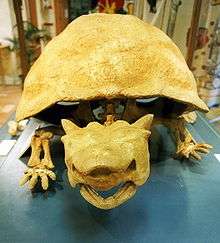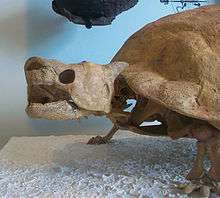Meiolania
| Meiolania Temporal range: mid Miocene–Holocene | |
|---|---|
 | |
| Cast of a Meiolania platyceps skeleton, American Museum of Natural History | |
| Scientific classification | |
| Kingdom: | Animalia |
| Phylum: | Chordata |
| Class: | Reptilia |
| Family: | †Meiolaniidae |
| Genus: | †Meiolania Owen, 1886[1] |
| Species | |
| Synonyms | |
| |
Meiolania ("small roamer") is an extinct genus of basal turtle[2][3] from the Middle Miocene to Holocene, with the last relict populations at New Caledonia which survived until 3,000 years ago.
Description


Meiolania had an unusually shaped skull that sported many knob-like and horn-like protrusions. Two large horns faced sideways, giving the skull a total width of 60 centimetres (2.0 ft), and would have prevented the animal fully withdrawing its head into its shell. The tail was protected by armored 'rings', and sported thorn-like spikes at the end.[4] The body form of Meiolania may be viewed as having converged towards those of dinosaurian ankylosaurids and xenarthran glyptodonts.
The animal was rather large, measuring 2.5 metres (8.2 ft) in length, making it the second-largest known nonmarine turtle or tortoise, surpassed only by Megalochelys atlas from Asia, which lived in the Pleistocene. It lived in Australia, Lord Howe Island, New Caledonia and Vanuatu.
The Meiolania specimens once living on New Caledonia and Lord Howe Island were much smaller than their giant relatives from the Australian continent.
Behaviour
Meiolania turtles fed on plants. Because the remains known by 1925 were found close to beaches, it was thought to be aquatic. It is now known to have been terrestrial.
Discovery and species


The genus was erected in 1886 based on remains found on Lord Howe Island, which Richard Owen assigned to the two species M. platyceps and M. minor (now a synonym of the latter).[1] These were the first good meiolaniid remains, and were used to show that the first known remains of a related animal, a species from Queensland now known as Ninjemys oweni (which was assigned to Meiolania until 1992), did not belong to lizards as initially thought, but to turtles.[5] Woodward sank Niolamia argentina into Meiolania, but this was not accepted by later authors.
In New Caledonia, M. mackayi was described from Walpole Island in 1925. It was smaller and less robust than M. platyceps.[6] Meiolania remains are also known from the Pindai Caves, Grande Terre, and from Tiga Island.[7]
M. brevicollis was described in 1992 from the mid Miocene Camfield Beds of northern Australia, and differed from M. platyceps in having a flatter skull and other horn proportions.[8]
Remains of M. damelipi have been found on the island of Efate in Vanuatu, associated with settlements from the Lapita culture.[7][9]
Possible meiolaniid remains have also been found on Viti Levu, Fiji.[10]
Extinction
It is thought that M. damelipi was hunted to extinction by the Lapita people about 3,000 years ago, based on the presence of bones at the bottom of a garbage midden at an archeological site.[7][9] The remains were primarily leg bones, indicating the turtles were butchered elsewhere.[7] The bones were not present in younger layers of the mound, suggesting the turtles disappeared within 300 years of first human contact.[7][9]
See also
References
- 1 2 3 Owen, Richard (January 1, 1886). "Description of Fossil Remains of Two Species of a Megalanian Genus (Meiolania) from "Lord Howe's Island"". Philosophical Transactions of the Royal Society. 177: 471–480. doi:10.1098/rstl.1886.0015.
- ↑ Joyce, Walter G. (April 2007). "Phylogenetic relationships of Mesozoic turtles". Bulletin of the Peabody Museum of Natural History. 48: 3–102. doi:10.3374/0079-032X(2007)48[3:PROMT]2.0.CO;2.
- ↑ Anquetin, Jérémy (2012) [9 November 2011]. "Reassessment of the phylogenetic interrelationships of basal turtles (Testudinata)". Journal of Systematic Palaeontology. 10: 3–45. doi:10.1080/14772019.2011.558928.
- ↑ Palmer, D., ed. (1999). The Marshall Illustrated Encyclopedia of Dinosaurs and Prehistoric Animals. London: Marshall Editions. p. 67. ISBN 1-84028-152-9.
- ↑ http://www.biodiversitylibrary.org/pdf3/005970900084521.pdf
- ↑ Anderson, C. (1925). "Notes on the extinct Chelonian Meiolania, with a record of a new occurrence". Records of the Australian Museum. 14 (4): 223–242. doi:10.3853/j.0067-1975.14.1925.844.
- 1 2 3 4 5 White, A. W.; Worthy, T. H.; Hawkins, S.; Bedford, S.; Spriggs, M. (2010-08-16). "Megafaunal meiolaniid horned turtles survived until early human settlement in Vanuatu, Southwest Pacific". Proc. Natl. Acad. Sci. USA. 107 (35): 15512–15516. PMC 2932593
 . PMID 20713711. doi:10.1073/pnas.1005780107. Retrieved 2011-08-30.
. PMID 20713711. doi:10.1073/pnas.1005780107. Retrieved 2011-08-30. - ↑ Megirian, D. (1992). "Meiolania brevicollissp. Nov. (Testudines: Meiolaniidae): A new horned turtle from the Australian Miocene". Alcheringa: an Australasian Journal of Palaeontology. 16 (2): 93–106. doi:10.1080/03115519208619035.
- 1 2 3 Keim, Brandon (2010-08-17). "Extinct, King Koopa-Style Giant Turtle Found on Pacific Island". Wired. (Popular presentation of some material from the PNAS article)
- ↑ Worthy, T. H.; Anderson, A. J.; Molnar, R. E. (1999). "Megafaunal expression in a land without mammals-the first fossil faunas from terrestrial deposits in Fiji (Vertebrata: Amphibia, Reptilia, Aves)". Senckenbergiana biologica. 79 (2): 237–242. Retrieved 2012-03-04.
Further reading
- Cox, Barry; Harrison, Colin; Savage, R. J. G.; Gardiner, Brian; Palmer, Douglas (1999). The Simon & Schuster Encyclopedia of Dinosaurs and Prehistoric Creatures: A Visual Who's Who of Prehistoric Life. Simon & Schuster. ISBN 0-684-86411-8. OCLC 40943525.
External links
- Meiolania platyceps Owen (The Australian Museum; photo)
- Mikko's Phylogeny Archive on Cryptodira